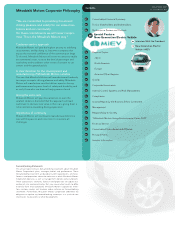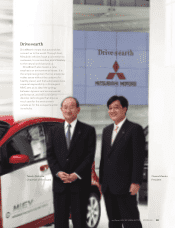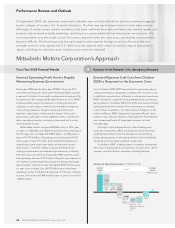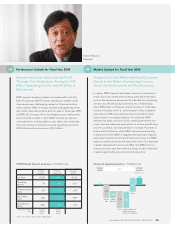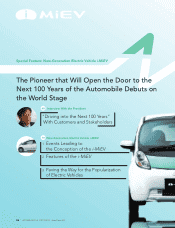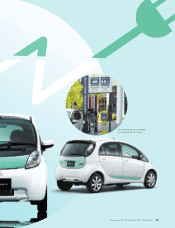Mitsubishi 2009 Annual Report Download - page 12
Download and view the complete annual report
Please find page 12 of the 2009 Mitsubishi annual report below. You can navigate through the pages in the report by either clicking on the pages listed below, or by using the keyword search tool below to find specific information within the annual report.
New-Generation Electric Vehicle i-MiEV
Events Leading to the Conception of the i-MiEV
MMC has poured all of its achievements in EV technology research, dating back to 1966,
into its new-generation electric vehicle, the i-MiEV. The road to market launch has been
paved with a wide range of rigorous testing, including extended rough road testing, water-
resistance testing, and crash testing. Following enhancements to basic vehicle performance,
comfort, and practicality through 500,000 km of proving tests, the i-MiEV was born.
1966 2009
Adoption of Lithium-ion Batteries:
The Challenge of Reducing Battery Weight
Until the beginning of the 1990s, lead-acid batteries were the predominant power source for electric vehicles,
but the weight of these batteries was a bottleneck to commercialization, as they accounted for around half the
vehicle weight. MMC quickly focused on lithium-ion batteries, which can be made compact and lightweight
while offering superior energy and output density. By utilizing lithium-ion batteries, the i-MiEV became com-
mercially feasible with a battery-to-vehicle weight ratio of less than 20%.
Packaging that Effectively Utilizes a Rear-Midship Layout
The i-MiEV was developed based on the “i” minicar. The long wheelbase, a feature of the “i” minicar’s rear-
midship layout, provides space for high capacity lithium-ion drive batteries under the floor and for the power
unit under the luggage compartment. This layout provides a driving range that is ample for everyday use with-
out sacrificing the generous seating and luggage space of the “i” minicar.
1
1970 1980 1990 2000 2010
Reducing atmospheric pollution Reducing global warming Reducing oil dependency
Lithium-ion battery
• U.S. Clean Air Act Amendment • Kyoto Protocol becomes operative
Start of government/private sector joint
development of EVs
Toward a low-carbon society
Zero-emission vehicle bill in the U.S.
Lead-acid battery
Libero EV FTO EVMinica EV/Minicab EV i-MiEV
History of EV development at Mitsubishi Motors
Gasoline-powered i i-MiEV
Engine &
transmission
Fuel tank
Motor &
transmission
Drive battery pack
Inverter
On-board charger &
DC/DC converter
• U.S. ZEV Law
10 MITSUBISHI MOTORS CORPORATION Annual Report 2009


